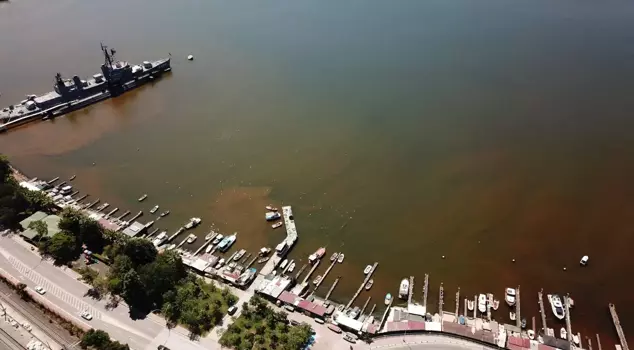
19.06.2025 11:12
In the Izmit district of Kocaeli, the sea water near the coastline has turned brown.
```html
In the Izmit district of Kocaeli, the sea water has turned brown in areas close to the coastline. The color change in the Izmit Bay was captured from the air, while Prof. Dr. Halim Aytekin Ergül from Kocaeli University (KOÜ) stated, "Of course, this is not a desired situation, but it is a phenomenon we occasionally encounter in the Izmit Bay, Gemlik Bay, and similar coastal ecosystems. These formations certainly have the potential to harm other living beings in the ecosystem." A part of the Izmit Bay has turned brown. The color change in nearby points along the coastline in the Izmit district has affected a wide area. Teams from the Environmental Protection and Control Department of Kocaeli Metropolitan Municipality have started working to determine the cause of the color change. Prof. Dr. Halim Aytekin Ergül, a faculty member in the Biology Department of KOÜ Faculty of Arts and Sciences, stated that the phenomenon is something observed in many coastal ecosystems around the world.
'WE ENCOUNTER THESE FORMATIONS FROM TIME TO TIME'
Prof. Dr. Halim Aytekin Ergül said, "As far as we can see in the samples we examined, this incident is due to the excessive proliferation of a group of phytoplankton known as dinoflagellates. It is generally a phenomenon encountered during periods referred to as 'seasonal transitions,' when air temperatures, water temperatures, and wind regimes change. Technically, it is an event that occurs following an increase in the number of dinoflagellates in a limited volume of microorganisms. Of course, this is not a desired situation, but it is a phenomenon we occasionally encounter in the Izmit Bay, Gemlik Bay, and similar coastal ecosystems. These formations certainly have the potential to harm other living beings in the ecosystem. It is particularly possible for more planktonic or macrobenthic organisms, such as amphipods, to be harmed by these events. Therefore, we can think of them as undesirable occurrences. However, in coastal ecosystems, even though wastewater treatment plants are functioning well, we still encounter these formations from time to time," he said.
'THE POPULATION IS VERY DENSE, THE AMOUNTS OF DISCHARGES ARE VERY HIGH'
Prof. Dr. Ergül stated that one of the most effective methods to prevent such formations is to convert wastewater treatment plants into facilities that perform advanced treatment. "We have facilities around the Izmit Bay that use this advanced technology, but on the other hand, the population is very dense; the amounts of discharges are very high. When air and water temperatures reach values that these organisms prefer, we encounter such formations. Of course, it is not just the amounts being discharged; we also need to consider the nutrient elements that are already present in the water but are activated by meteorological factors such as winds. Last week, during periods when the weather was a bit windy, it is possible that the water was mixed, and subsequently, these organisms utilized the nutrient elements here. Previous events and processes have always been experienced in this way. The organism we see here is technically a type of dinoflagellate called 'Prorocentrum micans.' Globally, the occurrence of algal blooms caused by this organism, known as 'red tide,' is among the frequently encountered events," he said.
'IT SHOULD BE TAKEN SERIOUSLY'
Prof. Dr. Ergül stated that these formations do not directly harm human health. "However, when they occur, they can affect other organisms in the ecosystem they inhabit. In a previous study we conducted, we observed that amphipods, which are consumed as food by fish, clogged their gills and caused their deaths. Therefore, we are facing the harms of these formations in terms of causing chain reactions that affect each other and lead to ecosystem degradation. There is no need for people to be directly alarmed, but it should be taken seriously due to both visual aspects and the ecosystem damages I mentioned earlier," he said.
COMMENT ON MUCOUS
Prof. Dr. Ergül also made statements regarding mucilage, saying, "Prorocentrum micans is among the organisms known to contribute to mucilage formation. Therefore, while it is not a leading organism in this regard, it is one of the organisms that contribute to this formation. Thus, to prevent these formations, it is necessary to be as active as possible. Wastewater treatment plants need to be operated effectively and equipped with advanced technology," he said.
'POPULATION' WARNING FOR MARMARA
Prof. Dr. Ergül stated, "The population density in our region is quite high, and unfortunately, we see that this density is increasing every day. I read in a report that approximately 30,000 people are added to the Kocaeli population each year. Therefore, this is a very difficult burden to bear. Because every population added to Kocaeli has some output to the sea, one way or another. For this reason, measures should be considered regarding the increase in population in our cities with high population density in the Marmara Region, such as Kocaeli and Bursa, especially Istanbul. This is certainly not an easy task; measures should be taken by thinking in long-term perspectives of 5, 10, 20, or 50 years. The ever-increasing population is now pushing the load that the region can bear, and we are even encountering signs that indicate it is exceeding that load. Therefore, it is necessary to think about these issues without wasting much time," he said.
```